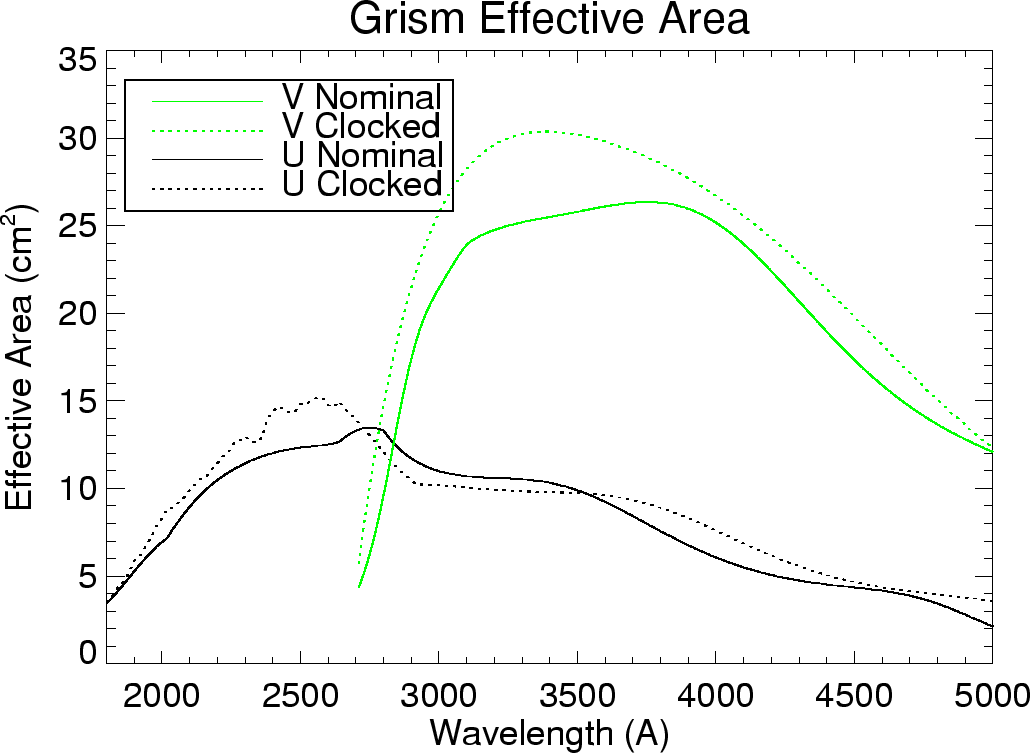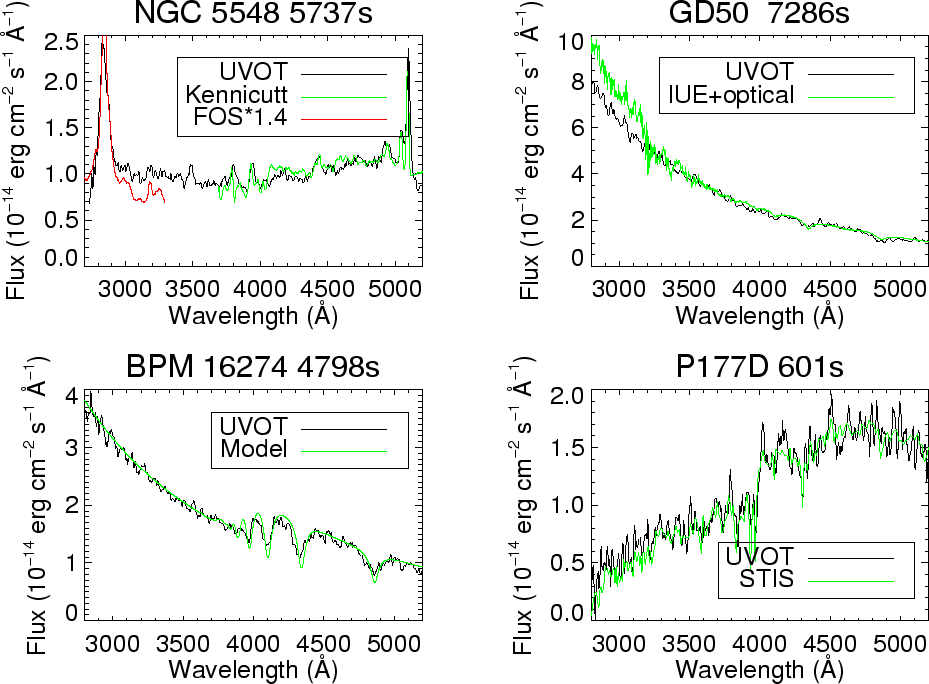Notes for Observing with the UVOT V Grism
Last updated: 16-Sep-2009: Updated software statusThe UVOT UV grism can provide 2800 - 5200 Å spectra of modest S/N and spectral resolution R ~ 75 for stars in the magnitude range 13-17. The V grism spectrum actually extends longward of 5200 Å but these longer wavelength regions can be confused by overlap from second-order light. Note that the V grism is more sensitive than the UV grism for the longest wavelength UV light (2900 -3200 Å).
The following decisions need to be made when observing with the V grism:
- Slew in place?: The pointing accuracy after an initial slew may be only 1 or 2 arcminutes. The use of a second slew after the arrival at the target (a "slew in place") can reduce the pointing uncertainty to a few arcseconds. Unlike the UV grism, the sensitivity and wavelength calibration of the V grism do not have a large dependence on the detector position. However, large offset may place part of the spectrum off of the detector, or (for a clocked observation) in a vignetted region. Note that one often one tries to avoid observing with the grism during the first few and last few minutes of an orbit anyway (because the sky background is large) so the use of a slew in place does not affect the prime grism science time.
- Clocked or Nominal Mode?: Zero-order spectra only appear in the area covered by the grism, whereas first-order spectra can be dispersed off the edge of the grism. Thus, ithe use of clocked mode can mimimize the contamination of first-order spectra by unrelated zeroth-order images. Clocked mode also suppresses the total sky flux, and for that reason must be used in crowded fields (e.g. low Galactic latitudes). Clocked mode also has slightly better sensitivity (see below). One disadvantage of clocked mode is that it introduces vignetting and so spectra are retrieved over a smaller field, which may be important for extended sources or if a slew in place is not used. For sparse fields, the choice between clocked and nominal mode is often decided by which one gives a better roll angle for a particular observing date.
- Roll Angle: The contamination of grism spectra by zero and first order of unrelated sources depends on the roll angle of the observation. An IDL grism simulator is available at http://idlastro.gsfc.nasa.gov/ftp/landsman/simgrism/ which displays a DSS image with simulated dispersed spectra for a given roll angle. (This software can be run under the IDL virtual machine, without an IDL license.) For a given observing time, the planners have very limited flexibility in choosing the roll angle. However, the simulator can be used to select a range of good observing dates or to choose between clocked and nominal model.
- Exposure time:
The June 2006 effective area for the V grism is given in the table
below. Note that this effective area is for computing the count rate
integrated perpendicular to the dispersion, and that the dispersion
varies from about 5.0 Å/pixel near 2800 Å to about 6.5
Å/pixel near 5300
Å. The "Cts/s" column gives the predicted counts/s (per pixel
integrated
perpendicular to the dispersion) for a source with a flat spectrum of
10^(-14) erg cm(-2) s(-1) Å(-1).
| Wavelength | Nominal | Clocked | ||
|---|---|---|---|---|
| (Å) | cm^2 | Cts/s | cm^2 | Cts/s |
| 2800 | 9.6 | 0.07 | 14.7 | 0.11 |
| 2900 |
17.4 |
0.13 |
21.5 |
0.16 |
| 3000 |
21.4 |
0.17 |
25.7 |
0.20 |
| 3100 |
23.9 |
0.20 |
28.3 |
0.23 |
| 3200 |
24.8 |
0.21 |
29.6 |
0.26 |
| 3300 |
25.2 |
0.23 |
30.3 |
0.27 |
| 3400 |
25.5 |
0.24 |
30.4 |
0.29 |
| 3500 |
25.8 |
0.25 |
30.2 |
0.30 |
| 3600 |
26.1 |
0.27 |
29.8 |
0.30 |
| 3700 |
26.3 |
0.28 |
29.3 |
0.31 |
| 3800 |
26.3 |
0.29 |
28.6 |
0.31 |
| 3900 |
26.0 |
0.29 |
27.7 |
0.31 |
| 4000 |
25.2 |
0.30 |
26.7 |
0.31 |
| 4100 |
24.0 |
0.29 |
25.6 |
0.31 |
| 4200 |
22.4 |
0.28 |
24.3 |
0.30 |
| 4300 |
20.7 |
0.27 |
22.9 |
0.30 |
| 4400 |
19.0 |
0.25 |
21.4 |
0.29 |
| 4500 |
17.3 |
0.24 |
19.8 |
0.27 |
| 4600 |
15.9 |
0.23 |
18.2 |
0.26 |
| 4700 |
14.7 |
0.22 |
16.6 |
0.24 |
| 4800 |
13.7 |
0.21 |
15.1 |
0.23 |
| 4900 |
12.8 |
0.20 |
13.6 |
0.21 |
| 5000 |
12.1 |
0.19 |
12.3 |
0.20 |
| 5100 |
11.4 |
0.19 |
11.1 |
0.18 |
| 5200 |
10.8 |
0.18 |
10.1 |
0.17 |
Effective Area
The effective area for all four grism modes is plotted below. Note that although the UV grism can record a visible spectrum, the sensitivity is less than half that of the V grism, and can suffer siginificant contamination from second-order UV light.
Caveats
Some considerations to be aware of when using the UV grism.- A single grism spectrum shows a fixed pattern noise
that is
only partially suppressed by applying a mod-8 correction. It may be
useful to combine
spectra with shifted zero order positions to further suppress this
fixed-pattern noise.
- There is currently no method to correct for coincidence losses of bright spectra. Co-I losses will begin at long wavelength at a flux of approximately 10^(-13) erg cm-2 s-1 Å-1.
- The wavelength anchor point is defined by the centroid of the zeroth order. However, because the zeroth order is dispersed the position of the anchor point may vary with spectral shape. In addition, mod-8 noise may shift the position of the centroid. Finally, the zeroth order (which contains both UV and visible light) is often saturated. So there may be a zero point shift of up to 2-3 pixels ( 15 Å).
- The grism has only recently been used to
study GRBs (see Kuin et al.
2009)
, and thus until recently the
SWIFT
grism tools (e.g. uvotimgrism) have been given low
priority. A new
tool uvotgraspcorr is now available to compute an astrometric solution
for grism images. This allows the centroid of the zero
order to
specfied by giving the source RA and Dec, This
astrometric
correction is not yet in the UVOT pipeline, but grism users can
request astrometrically corrected images and the default
extracted 1-d
spectra.
Example Spectra
Four examples of UVOT V grism spectra are shown below. The first shows a UVOT spectrum of NGC 5548 compared with a HST/FOS near-UV spectrum, and optical spectrsphotometry from Kennicutt. The second compares the V=13.8 hot white dwarf GD 50 with combined optical spectrophotometry and IUE observations. (Note that the IUE spectrum does not appear to smoothly connect with the optical spectrophotometry at 3200 Å.) The third examples compares a UVOT spectrums of the hot white dwarf BPM 16274 with a model atmosphere. The last spectrum compares UVOT spectra of the V=13.7 solar analog P177D with a STIS spectrum.


